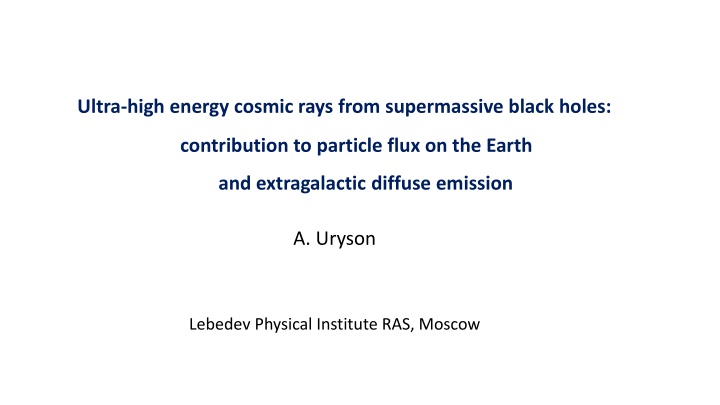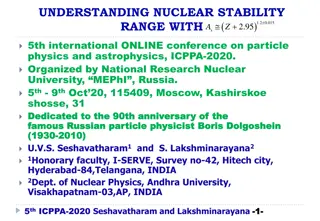
High-Energy Cosmic Rays from Supermassive Black Holes
Explore the generation of ultra-high-energy cosmic rays from supermassive black holes and their impact on Earth, extragalactic diffuse emission, and cosmogenic neutrino flux. Models, computational results, and data comparisons with observatories are discussed. Understand the interaction of cosmic rays with background photons, leading to gamma-ray flux in extragalactic space.
Download Presentation

Please find below an Image/Link to download the presentation.
The content on the website is provided AS IS for your information and personal use only. It may not be sold, licensed, or shared on other websites without obtaining consent from the author. If you encounter any issues during the download, it is possible that the publisher has removed the file from their server.
You are allowed to download the files provided on this website for personal or commercial use, subject to the condition that they are used lawfully. All files are the property of their respective owners.
The content on the website is provided AS IS for your information and personal use only. It may not be sold, licensed, or shared on other websites without obtaining consent from the author.
E N D
Presentation Transcript
Ultra-high energy cosmic rays from supermassive black holes: contribution to particle flux on the Earth and extragalactic diffuse emission A. Uryson Lebedev Physical Institute RAS, Moscow
We discuss ultra-high energy cosmic rays from supermassive black holes and their contribution to the particle flux on the Earth along with diffuse gamma-ray emission and cosmogenic neutrino flux which are produced in space via UHECR interaction with background photons.
UHECR generation in supermassive black holes (SMBH) Models of UHECR generation in SMBHs with various particle energy spectra are considered. CR spectra at the Earth and the intensity of quanta and neutrinos produced by CRs in extragalactic space are obtained. The computational results are compared with the data by Pierre Auger Observatory and Telescope Array, and the data by Fermi LAT and IceCube. It appears that the model CR flux at the Earth is much lower than that measured. But in extragalactic space CRs generate noticeable cascade gamma-ray flux. So these UHECRs should be accounted for analyzing components of extragalactic diffuse gamma-ray emission.
Data on UHECRs obtained at PAO and TA: CR arrival directions, composition, anisotropy, the energy spectrum. The energy spectrum due to GZK-effect its shape differs from that of an injection spectrum. Another manifestation of GZK-effect: extragalactic electromagnetic cascades (Hayakawa 1966; Prilutsky Rozental, 1970).
In space, UHECRs interact with cosmic microwave background and extragalactic background light: p+ b p+ 0, p+ b n+ +. 0 + , + ++ , + e++ e+ + b e++ e- e+ b e'+ ' . As a result electromagnetic cascades are initiated by UHECRs in extragalactic space. Consequently UHECRs contribute to isotropic gamma-ray background and to astrophysical neutrino flux.
Isotropic gamma-ray background (IGRB) is measured by Fermi LAT. Fermi LAT data are used for UHECR study as follows. 1) different classes of active galactic nuclei (AGN) which are possible UHECR sources are considered; UHECR spectra at the Earth are calculated to fit the measured spectrum. 2) gamma-ray emission Iggenerated by UHECRs in extragalactic space is calculated; 3) the calculated gamma-ray intensity is compared with the Fermi LAT IGRB, and models of UHECR sources in which UHECR contribution in IGRB Igis Ig > Fermi LAT IGRB are excluded. See e.g. Giachinti et al. 2015; Gavish, Eichler 2016; Berezinsky et al 2016, where possible UHECR sources are AGNs; to fit spectra measured injection spectra are exponential: index a 2.2, or around 2.6 depending on cosmological evolution of AGN.
We assume that UHECRs are accelerated in supermassive black holes (SMBH): by electric fields (Blandford-Znajek mechanism for the extraction of energy from a rotating black hole (MNRAS 1977); in regions of accretion disks particles can be accelerated to 1021eV by electromagnetic fields with explosive growth (Haswell, Tajima, Sakai 1992).
THE MODEL CR sources are pointlike. They are SMBHs. UHECRs are protons. Other assumptions concern three points: 1) CR sources injection spectra and evolution 2) Extragalactic background emission 3)Extragalactic magnetic fields
Possible injection spectra are chosen depending on acceleration mechanism. Blandford-Znajek mechanism: we suppose that generation of particles is equiprobable at any energy in between 1019 1021eV. Then spectral index a=0. Haswell-Tajima-Sakai model: we suppose that the injection spectrum is hard, a> -2.2.
Source evolution We suppose that UHECR sources are located at distances z 0.05. Source evolution influences on the CR spectrum measured (e.g. Uryson 1998; Berezinsky, Gazizov, Kalashev 2016; Gavish, Eichler 2016). SMBH evolution is not quite clear yet. In the model we use a scenario of BL Lac evolution (Di Mauro et al., 2014; Kalashev, Kido 2015).
Extragalactic background emission Cosmic microwave background: Planck distribution, < r>=6.7 10-4eV, <nr>=400 m-3. Extragalactic background light: Inoue et al. 2013. Extragalactic radio background: Protheroe, Biermann 1996.
Extragalactic magnetic fields seem to be inhomogeneous: 1 10 17Gs < B <3 10 6Gs (Kronberg 2005; Essey, Ando and Kusenko 2011; Dzhatdoev et al. 2017). Fields B< 10-9 10-8Gs do not break cascades. Fields of B 10 6Gs disturb cascades due to electron synchrotron emission. We suppose that regions where extragalactic fields are of 10 6Gs occupy a small part of extragalactic space and neglect them. We assume that extragalactic magnetic fields do not break cascades.
COMPUTING the public available code TransportCR (Kalashev, Kido 2015).
Comparing PAO data and model spectra we use 1) PAO spectrum: fit by Verzi, Ivanov, Tsunesada 2017; 2) model spectra are normalized to PAO spectrum at the energy 1019.5eV (3.16 1019eV).
25 PAO and proton model spectra Lg (J*E3) 24 23 22 PAO calcul: a=1. calcul: a=0 calcul: a=2.2 calcul: a=0.5 21 20 18 18.5 19 19.5 20 20.5 Lg E, eV
Model spectra are several orders lower than PAO spectrum and differ strongly in shape. This is true for TA spectrum also because at E 1019.5eV difference between TA and PAO spectra is 20-30%, at E>1019.5eV PAO data is 8-9 times lower than TA data (Verzi, Ivanov, Tsunesada 2017). Hence SMBHs contribute negligibly to CR flux detected by ground arrays. What is the UHECR contribution to the diffuse gamma-ray emission?
Gamma-ray emission generated by UHECR in extragalactic space Diffuse gamma-ray intensity calculated a=0: I (E>50 GeV) = 5.416 10-10 (cm-2s-1sr-1), (1) a =-0.5: I (E>50 GeV) = 4.123 10-10 (cm-2s-1sr-1), (2) a =-1: I (E>50 GeV) = 3.056 10-10 (cm-2s-1sr-1), (3) a =-1.8: I (E>50 GeV) = 2.015 10-10 (cm-2s-1sr-1), (4) a =-2.2: I (E>50 GeV) = 2.376 10-11 (cm-2s-1sr-1). (5) The range E>50 GeV is chosen to compare model gamma-ray intensity with Fermi LAT data as the theoretical estimate of unresolved gamma-ray sources in this range is given (Di Mauro 2016).
We do not discuss the form of cascade gamma-ray spectra because it depends negligibly on CR injection spectra (Berezinsky, Kalashev 2016; Dzhatdoev et al. 2017).
Fermi LAT IGRB (E>50 GeV)=1.32510-9(cm-2s-1sr-1) IGRB = unresolved sources + extragalactic diffuse emission Contribution of unresolved sources at E>50 GeV: 86 (+16, -14) % (Di Mauro 2016) Deducting contribution of unresolved sources 86% IGRB without blazars(E>50 GeV) =1.855 10-10 (cm-2s-1sr-1). (7) Deducting contribution of unresolved sources 86%-14%=72% IGRB without blazars(E>50 GeV) =3.710 10-10 (cm-2s-1sr-1). (8)
Accounting for uncertainties in Fermi LAT IGRB (including systematic ones and those in foreground model A ): 2.20x10-10 FERMI LAT IGRB (without blazars) 5.40x10-9(cm-2s-1sr-1) I (E>50 GeV)< IGRB without blazars(E>50 GeV) is satisfied in models with exponential injection spectra with a=0, -0.5, -1, -1.8, 2.2.
Cascade neutrino fluxes Cascade neutrino fluxes -7 -9 -11 Lg (E2*J(E) (GeV cm-2s-1sr-1) -13 -15 -17 -19 a=0 a=0.5 a=1. -21 a=1.8 a=2.2 -23 -25 2 4 6 8 10 12 Lg E, GeV
Model fluxes of cosmogenic neutrino are several orders lower than IceCube flux in the range E 1011 1015eV . Model neutrino spectra at the energies E >1019eV depend on injection spectra, however this energy range is out of reach for operating neutrino telescopes.
Conclusion Possibly, SMBHs are UHECR sources which contribute a little in CR flux at the Earth. However particles generate a noticeable flux of diffuse gamma-ray emission in relation to Fermi LAT data. The intensity of gamma-rays depends on UHECR injection spectra formed in SMBHs. Therefore we conclude: It is necessary to account for possible SMBH contribution in diffuse gamma-ray emission analyzing UHECR sources, UHECR chemical composition, dark matter decays. Possibly data on diffuse gamma-ray emission can be applied to study processes in SMBH. Results obtained depend mainly on contribution of unresolved gamma-ray sources in the gamma-ray flux measured.






















